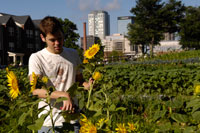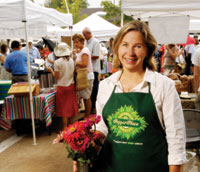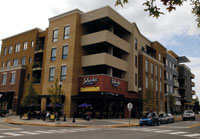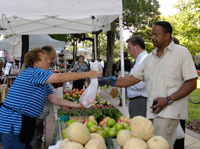Planning New Life for Birmingham
By Caperton Gillett
 A sidewalk is a way to get from one point to another. A park bench is a place to sit. A front stoop makes the distance from the ground to the front door that much easier to cover. A neighborhood is an inanimate object.
A sidewalk is a way to get from one point to another. A park bench is a place to sit. A front stoop makes the distance from the ground to the front door that much easier to cover. A neighborhood is an inanimate object.
Right?
That’s not the way Max Michael, M.D., dean of UAB’s School of Public Health, sees it. To him, a sidewalk is a crucial piece of public health infrastructure, a park bench is a gathering place, a front stoop is an antiviolence tool, and a neighborhood is a living, breathing organism.
“A neighborhood that works is one where there’s people traffic and people feel safe enough to talk with each other and pass information along,” Michael says. “Sidewalks and green spaces support that interactive traffic. There’s some good public health data that shows the stronger the social networks are within a neighborhood, the safer the neighborhood is and the healthier the people are.”
The idea that our surroundings play an active role in our lives is not limited to public health experts. As politicians, developers, and homebuyers focus on urban revitalization, this organic approach is helping to shape the debate about the best way to bring new life to old cities.
Building Community
One important consideration, says Michael—and one that is often ignored—is the need to preserve the life that exists in dysfunctional neighborhoods, not eradicate it. Catherine Sloss Crenshaw, president of Sloss Real Estate and a force behind revitalization in Birmingham, agrees. Her Park Place development, which replaced the city’s notorious Metropolitan Gardens public housing project, brings together residents of diverse income levels and backgrounds in the heart of downtown.
“Great cities are for everybody,” Crenshaw says. “We have an opportunity to rebuild urban neighborhoods that offer mixed-income housing. We have to come up with policies that will protect affordability, because if we don’t, we’ll just gentrify. And if we just gentrify, we have failed, in my opinion, because we will lose the character of cities.”
 Catherine Sloss Crenshaw has helped bring people together in downtown Birmingham with the Pepper Place Saturday Market (above), Jones Valley Urban Farm, and Park Place Market.
Catherine Sloss Crenshaw has helped bring people together in downtown Birmingham with the Pepper Place Saturday Market (above), Jones Valley Urban Farm, and Park Place Market.
Crenshaw has pondered this problem for years—in addition to Park Place, Sloss Real Estate has led several high-profile revitalization projects in Birmingham. But she was able to devote herself to the complexities of urban planning nearly full-time in 2006 and 2007, when she won a prestigious Loeb Fellowship to spend an academic year at Harvard University’s Graduate School of Design. While in Boston she studied design principles and “green” building techniques, analyzed different models for mixed-use and mixed-income development, and researched the value of urban forests and urban farms—anything that could help in her quest to create healthy neighborhoods built around a vital urban core.
This fall, Crenshaw will pass on her Harvard insights to UAB students in a special class that will explore ways to bring together environmental consciousness, public health, and a respect for history in urban design. She will also discuss the lessons she has learned from the landmark Park Place project. Part of the HOPE (Housing Opportunities for People Everywhere) VI initiative, Park Place is designed to bring low-income residents out of isolation and give them access to convenient and adequate food, work, and schools.
The development includes almost 500 housing units to date (40 percent are set aside for government-subsidized housing, 20 percent for low-income housing, and 40 percent at the market rate), but it is not just a collection of bedrooms. There is a local food source in the Jones Valley Urban Farm, as well as a new school for children from kindergarten through eighth grade, and an outlet for adolescent energies at the Youth Development YMCA. “The bottom line for how we improve overall public health has a lot to do with how we build community,” says Crenshaw, “which requires that we design neighborhoods that bring people together.”
Designed to Fail?
Building healthy, interconnected communities can help address inner-city crime problems, says UAB youth violence expert John Bolland, Ph.D. In fact, smart infrastructure improvements can be an antidote to the isolation and alienation so often seen in public housing complexes.
“People who are in public housing feel that, in order to survive, they need to mind their own business,” says Bolland. “So they probably aren’t terribly likely to report bad things that are going on that they observe. On the other hand, it’s quite possible that people just driving by, if they see a very obvious break-in, will report it.” But there are few people “just driving by” most public housing developments. That is because they are often physically isolated from other areas in a city, stranded at the end of a long road or surrounded by some physical barrier, such as an Interstate highway. This may be by design or by accident, says Bolland, but either way the result many times is that “it cuts off access on one whole side of the development,” reducing through traffic and creating a sense of alienation. Isolated residents feel they have no chance of escape, he says, diminishing their hope that things will improve in the future and reducing their disincentive to commit crimes.
Spinning Yarns
While it may not be possible to replace or relocate housing, Bolland says there are ways to develop social interaction in a community. He notes that butterfly gardens and rose gardens have been built around high-rise public housing communities in New York, along with playgrounds and other areas where residents can interact. “There’s a notion that park benches only attract people who loiter,” says Bolland. “But if you don’t have park benches near a playground, moms are not going to come out and stand for two hours while their children play on the swings.” And a successful community-watch program that encourages residents to patrol the neighborhood, he notes, will require benches so the watchers can take an occasional break.
 Developments such as Soho Square in the Birmingham suburb of Homewood aim to create tightly knit communities by placing residents and business owners in close proximity.
Developments such as Soho Square in the Birmingham suburb of Homewood aim to create tightly knit communities by placing residents and business owners in close proximity.
Even though he is an advocate of infrastructure improvements, Bolland emphasizes that such changes are not an immediate solution to crime. “There has to be some social program that’s going on in conjunction with the built environment to help address problems.” But these programs do not need to be overly elaborate, he says. In a study performed for the National Institute for Child Health and Human Development, Bolland found that the best way to address unwanted pregnancy, sexually transmitted diseases, and violence among minority adolescents could be as simple as a sewing circle.
“We found that to a large extent the neighborhood itself was creating problems,” Bolland says. He spent five years knocking on doors, trying to create a safe, supportive environment where residents could interact. Sewing circles, quilting bees, and exercise classes became social magnets, giving residents an opportunity to connect and support each other.
“When we think of urban revitalization programs, we tend to think of construction,” Bolland says. “But we have to realize that it’s also important to get out and promote social activities that allow new construction to be a positive influence. If people simply stay in their homes, then a new environment probably won’t have much of an impact.”
Learning to Love the City
Sometimes the invisible social and economic barriers of a city are far more confining than its buildings and streets. Conventional wisdom deems some areas safe and others to be off limits; a person’s home address can be as defining as a resume.
 Supermarkets are scarce in most urban settings, but regular events such as Birmingham’s Linn Park farmer’s market are bringing fresh options to the heart of the city.
Supermarkets are scarce in most urban settings, but regular events such as Birmingham’s Linn Park farmer’s market are bringing fresh options to the heart of the city.
Breaking through these barriers is the goal of “Exploring Birmingham,” one of the new Freshman Learning Communities at UAB. The communities encourage first-year students to bond by placing them in classes linked by a common theme—with “Exploring Birmingham,” the theme is “community” itself. Leader Rosie O’Beirne of UAB’s Center for Urban Affairs says her goal is to help students learn to appreciate the value of the people, infrastructure, and institutions in their own backyard.
“We have a lot of students who come to UAB who are not from Birmingham, so the urban environment is a new thing to them,” O’Beirne says. “Some express a fear of going downtown—they have this notion that it’s unsafe. So we start from there, breaking down some of those stereotypes as to what ‘urban’ is. The irony is that the greater population density you have, the safer you are in general, because a more bustling city is a thriving city.”
Ingredients of Community
Get In, Get OutLiterary Gridlock in Manhattan UAB English chair Peter Bellis, Ph.D., is a student of cities. Manhattan is his current focus, but not the glittering fashion plate of modern times. Through the pages of 19th-century literature—Horatio Alger’s Ragged Dick stories, Stephen Crane’s Maggie, a Girl of the Streets, and reform journalist Jacob Riis’s How the Other Half Lives—he is chronicling the shifting fortunes of the island’s early inhabitants. “Horatio Alger emphasized economic mobility and upward social movement for, in his case, young orphan boys, but implicitly for everyone,” Bellis says. “And that’s reflected in their ability to physically move about the city easily. Twenty years later, Stephen Crane is writing about comparable poor people, but his streets are congested. It’s physically impossible for them to move out of the ghetto. One of the characters drives a delivery wagon, and most of his job is in fact fighting with other drivers because the streets are so tightly congested.” In those two decades, says Bellis, “you move from an optimistic view of the city as a space anyone can move through to one that people are fighting to get out of—and unable to get out of.” Manhattan in the 19th century was, of course, much smaller than the Manhattan of today—it was merely the tip of the island in the early 1800s. As it grew, the connection between physical mobility and social mobility became ever more sharply defined. “As things began to get more congested, people began to move away from the business and commercial areas to establish separate residential areas,” Bellis says. “It was an economic movement away from the congestion of work areas by the middle and upper classes.” The void left by the fleeing wealthy was quickly filled with immigrants and working-class families who couldn’t begin to afford the pricey homes that had been abandoned. In How the Other Half Lives, Jacob Riis rails against a system where older homes abandoned by the upper classes were “taken over by slumlords and subdivided into tiny little apartments without air and light,” Bellis says. Suddenly, “what was a very nice middle- or upper-class neighborhood becomes a terrible tenement.” Ironically, urban renewal is bringing the process around full circle. Some of these same buildings have now been “cleaned up and turned back into larger apartments or homes,” says Bellis. “And they are now probably unaffordable.” |
O’Beirne’s students get to know Birmingham in the classroom, exploring the reasons behind the city’s current development pattern, such as the shift from steelmaking to a service and health-care economy and the exodus from downtown that has created the present “population doughnut,” with booming suburbs ringing a relatively empty inner city.
Then they hit the streets. Students explore ethnic and economic diversity at Park Place, where they learn that “a healthy community is a diverse community,” O’Beirne says. They also study New Urbanism and mixed-use space at the Soho Square development in Homewood. “Mixed-use spaces generate a reciprocity between residents and business owners,” says O’Beirne. “If you have them all in a relatively close space, then a community forms.” Soho Square is also cited as an example of mixed-income housing, “although often the students conclude that it isn’t really ‘mixed-income’ when the lowest condo there starts at about $250,000,” O’Beirne notes. But this is also part of their urban education, she says. Defining the concept of community—what should be there, what shouldn’t—is left up to the students, with help from the professors and experts they consult.
“In the end, we have this kind of conglomerate definition that forms,” says O’Beirne. “A place with a healthy economy, with diversity—that becomes a working definition in our class.” Students come to realize that a healthy community is self-contained, she says, with “health care and education and simple things like recreation very close at hand—not something you have to get in your car and drive 20 minutes to get to.”
At the beginning and again at the end of the course, students are asked to map out their concepts of community. O’Beirne says that most students’ initial maps mirror their own suburban upbringing. “There are strip malls, there are Wal-Marts, there’s lots of parking,” she says.
The end result is far different. “Suddenly, parking lots are parks. Parking is no longer in the garage in front of the house but rather in the back of the house,” O’Beirne says. “They recognize the value of things like sidewalks in getting people out on the streets and the way this creates vibrancy in the community. It puts people out in front of their homes to interact with each other.”
Downtown Makes a Comeback
Catherine Sloss Crenshaw long ago recognized the city planner’s responsibility to consider the public health implications of concrete and steel. And she predicts that the demand for new urban communities will increase as high gas prices and other factors drive suburban dwellers back to city centers.
“People are going to want to walk to work,” she says. “A lot of people work for UAB, and if you have to drive 31 miles a day—which we currently do per capita in Birmingham—and pay four dollars a gallon for gas, you’re going to think about moving back to the city.”
This trend will benefit overall environmental health and community health, Crenshaw says, as long as it is managed responsibly. By that she means making fresh foods available in areas where grocery stores are often scarce. She also notes the need to reform urban schools and develop workable public transportation, two areas in which she admits Birmingham could make improvements.
But Crenshaw is optimistic about the future. “I think because of our history and because of where we are, when we hit the note in Birmingham, it resonates,” she says. “When we do things well, it really makes a difference, and there’s a ripple effect. I think we have all the ingredients to be one of the really great cities in the country—with some cooperation and good luck.”